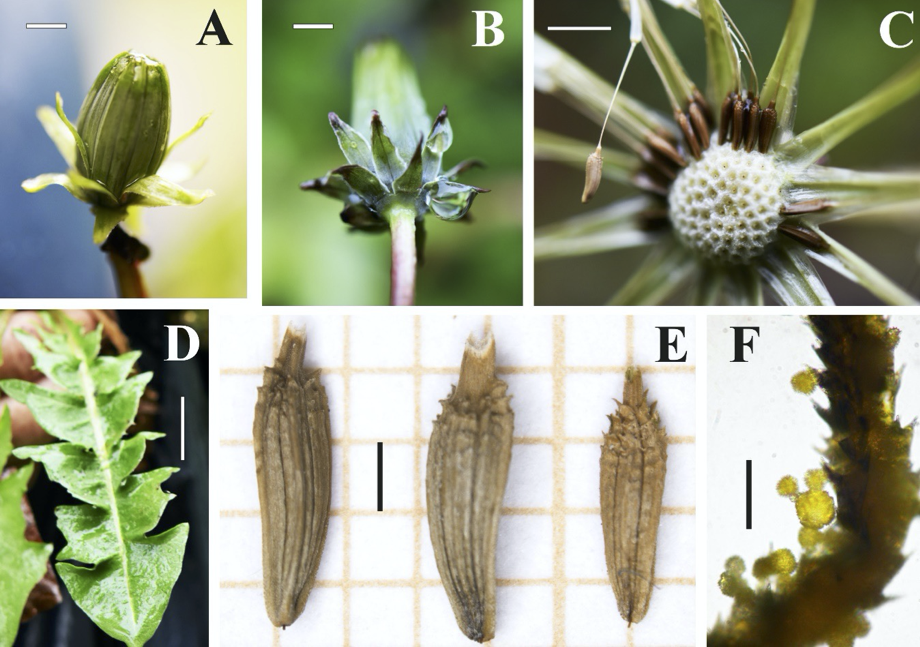Taraxacum fagacearum sp. nov. (Compositae, Cichorieae), y notas corológicas sobre otros dientes de león de la península ibérica
Mots-clés :
Dientes de león, nueva especie, nuevas citas, península ibérica, TaraxacumRésumé
Atendiendo a diferencias morfológicas respecto a otras especies del norte de la península ibérica y el resto de Europa occidental, se describe la nueva especie Taraxacum fagacearum de los hayedos y robledales de la Cordillera Cantábrica. Se dan a conocer por primera vez T. alatum H. Lindb., T. boekmanii Borgv., T. marklundii Palmgr. y T. subhamatum M. P. Christ., en algunas áreas del norte de España.
Téléchargements
Métriques
Références
De Kovel, C.G.F. & De Jong, G. (2000). Selection on apomictic lineages of Taraxacum at establishment in a mixed sexual-apomictic population. Journal of Evolutionary Biology, 13, 561-568. https://doi.org/10.1046/j.1420-9101.2000.00211.x
Dudman, A.A. & Richards, A.J. (1997). Dandelions of Great Britain and Ireland. London: Botanical Society of the British Isles.
Franco, J.A. & Rocha Afonso, M.L. (1984). Taraxacum Weber. In J.A. Franco (Ed.), Nova flora de Portugal, Vol. II (pp. 522-534). Lisboa: Sociedade Astória.
Galán de Mera, A. (2017). Taraxacum F.H. Wigg. [nom. cons.]. In S. Castroviejo (Coord.), Flora iberica Vol. XVI (II) (pp. 963-1062). Madrid: Real Jardín Botánico, CSIC.
Galán de Mera, A. & Linares Perea, E. (2022). Nuevas citas de Taraxacum F.H. Wigg. (Asteraceae) para la flora ibérica. Acta Botanica Malacitana, 47, 87-91. https://doi.org/10.24310/abm.v47i.14725
Galán de Mera, A. & Vicente Orellana, J.A. (2010). Taraxacum decastroi and T. lacianense (Asteraceae), two new species from the Iberian Peninsula. Annales Botanici Fennici, 47, 307-311.
Haglund, G.E. (1938). Bidrag till kännedomen om Skandinaviens Taraxacum-flora, II. Botaniska Notiser, 1938, 499-508.
Kirschner, J., Drábková, L.Z., Štěpánek, J. & Uhlemann, I. (2015). Towars a better understanding of the Taraxacum evolution (Compositae-Cichorieae) on the basis of nrDNA of sexually reproducing species. Plant Systematics and Evolution, 301, 1135-1156. https://doi.org/10.1007/s00606-014-1139-0
Kirschner, J., Štepánek, J. & Greuter, W. (2023). Taraxacum. In W. Greuter & E. Von Raab-Straube (Eds), Compositae. Euro+Med Plantbase - the information resource for Euro-Mediterranean plant diversity. Recurso electrónico e
n https://www.emplantbase.org/home.html. Consulta realizada el 10 de junio de 2023.
Lundevall, C.-F. & Øllgaard, H. (1999). The genus Taraxacum in the Nordic and Baltic countries: Types of all specific, subspecific and varietal taxa, including type locations and sectional belonging. Preslia, 71, 43-171.
Marklund, G. (1938). Die Taraxacum-Flora Estlands. Acta Botanica Fennica, 23, 2-140.
Matysiak, J.P., Tison, J.M. & Ferrez, Y. (2014). Taraxacum F.H. Wigg. In J.M. Tison & B. De Foucault (Coords.), Flora Gallica. Flore de France (pp. 477-508). Mèze: Biotope Éditions.
Mercadal Corominas, G. & Galán de Mera, A. (2017). Taraxacum sect. Palustria (Compositae) en la península ibérica. Anales del Jardín Botánico de Madrid, 74(2), e064. https://doi.org/10.3989/ajbm.2490
PhotoFlora. (2023). PhotoFlora. Base de données de photos de plantes essentiellement de la flore européenne: 200608 photos en ligne. Recurso electrónico en http://www.photoflora.fr/RechTax.php. Consulta realizada el 5 de junio de 2023.
Richards, A.J. (2003). Apomixis in flowering plants: an overview. Philosophical Transaction of the Royal Society of London B, 358, 1085-1093.https://doi.org/10.1098/rstb.2003.1294
Richards, A.J. (2012). Taraxacum section Hamata. Plant Crib, 3, 1-10.
Richards, A.J. & Sell, P.D. (1984). Taraxacum Weber. In T.G. Tutin, V.H. Heywood, N.A. Burges, D.M. Moore, D.H. Valentine, S.M. Walters & D.A. Webb (Eds.), Flora Europaea Vol. 4 Plantaginaceae to Compositae (and Rubiaceae) (pp. 332-343). Cambridge: Cambridge University Press.
Silvertown, J. (2008). The evolutionary maintenance of sexual reproduction: Evidence from the ecological distribution of asexual reproduction in clonal plants. International Journal of Plant Sciences, 169, 157-168. https://doi.org/10.1086/523357
Soest, J.L. (1958). The phytogeography of Taraxacum, with special reference to Europe. Blumea, suppl., 4, 60-67.
Thiers, B. (2023). Index herbariorum. Recurso electrónico en https://sweetgum.nybg.org/science/ih/. Consulta realizada el 19 de octubre de 2023.
Trávníček, B. & Vašut, J. (2011). Notes on the genus Taraxacum in Slovakia. I. Taraxacum sect. Hamata: a new group of dandelions in Slovakia. Biologia, 66(4), 595-603. https://doi.org/10.2478/s11756-011-0058-6
Uhlemann, I. (2001). Distribution of reproductive systems and taxonomical concepts in the genus Taraxacum F.H. Wigg. (Asteraceae, Lactuceae) in Germany. Feddes Repertorium, 112, 15-35.
https://doi.org/10.1002/fedr.4921120105
Uhlemann, I. (2003). Die Gattung Taraxacum (Asteraceae) im östlichen Deutschland. Sonderheft: Mitteilungen zur floristichen Kartierung in Sachsen-Anhalt.
Van Baarlen, P., Van Dijk, P.J., Hoekstra, R.F. & De Jong, J.H. (2000). Meiotic recombination in sexual diploid and apomictic triploid dandelions (Taraxacum officinale L.). Genome, 43, 827-835. https://doi.org/10.1139/g00-047
Villar, L., Sesé, J.A. & Vicente Ferrández, J. (2001). Atlas de la flora del Pirineo aragonés, vol. II. Huesca: Instituto de Estudios Altoaragoneses-Consejo de Protección de la Naturaleza de Aragón.

Téléchargements
Publiée
Comment citer
Numéro
Rubrique
Licence
(c) Tous droits réservés Acta Botanica Malacitana 2024

Ce travail est disponible sous licence Creative Commons Attribution - Pas d’Utilisation Commerciale - Partage dans les Mêmes Conditions 4.0 International.
Les auteurs qui ont des publications avec cette revue acceptent les termes suivants:
a. Les auteurs conserveront leurs droits d'auteur et garantiront à la revue le droit de première publication de leur travail, qui sera simultanément soumis à la licence Creative Commons Attribution-Non-Commercial 4.0 dont le texte intégral se trouve sur <http: // creativecommons .org / licences / by-nc / 4.0> qui permet à des tiers de partager l'œuvre tant que son auteur et sa première publication sont indiqués, et tant que ce n'est pas à des fins commerciales.
b. Les auteurs peuvent adopter d'autres accords de licence non exclusifs pour la distribution de la version de l'œuvre publiée (par exemple, la déposer dans une archive télématique institutionnelle ou la publier dans un volume monographique) à condition que la publication initiale dans cette revue soit indiquée .
c. Les auteurs sont autorisés et recommandés à diffuser leur travail sur Internet (par exemple, dans les archives télématiques institutionnelles ou sur leur site Web) avant et pendant le processus de soumission, ce qui peut produire des échanges intéressants et augmenter les citations. des travaux publiés. (Voir L'effet de l'accès ouvert).


1.png)
